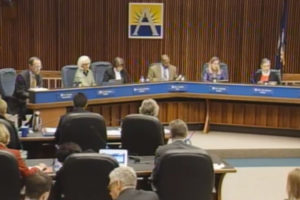 The Arlington School Board has vowed to work with the county government to find short-term fixes to South Arlington’s elementary school capacity crisis.
The Arlington School Board has vowed to work with the county government to find short-term fixes to South Arlington’s elementary school capacity crisis.
In response the Arlington County Board’s decision to say “not now” to APS’ plan to build a new elementary school next to Thomas Jefferson Middle School, the School Board delivered a joint statement last night, agreeing to work with the county to find creative solutions to fit the hundreds of new students coming to the county every year.
“We appreciate the County Board’s commitment to partnering with the School Board to provide a minimum of 725 new elementary school seats in South Arlington not later than the start of school in September 2018, using a combination of interim and permanent solutions,” the School Board’s statement reads. “This commitment increases the variety of options available. The County Board has offered to provide technical support to identify and evaluate County buildings and private commercial spaces that might help meet our capacity needs on an interim basis.”
The School Board took turns reading from parts of the statement at its meeting. The five members said they will start another community engagement process of their own, including directing Superintendent Patrick Murphy to work with County Manager Barbara Donnellan on identifying county- and privately-owned sites that could accommodate school uses.
Murphy is also charged with, according to the School Board’s statement, outlining “a process and timeline for considering solutions that enable us to meet our deadline of providing a minimum of 725 new elementary school seats in South Arlington by the start of school in September 2018.” That includes spending the approved $50.25 million bond funds, approved in November for the purpose of a more South Arlington elementary school seat.
Murphy has been directed to return before the School Board by April 30 with a status report on his conversations with the county and community engagement. The Board did not set a deadline for a complete recommendation or when it would make a decision.
The School Board also asked Murphy and APS facilities staff to “update APS feasibility studies of APS properties, as appropriate.” One of the County Board’s criticisms of the schools’ recommendations was a lack of study of the broader impact of a new school.
“The School Board is optimistic that more options will serve our community better,” the School Board statement reads. “We are moving forward in collaboration with the County Board and will work to build community consensus around capacity solutions. Together with Dr. Murphy, APS staff, the community, and the County Board and its staff, we are confident that we will maintain our focus on student achievement as we meet our capacity challenges.”
School Board Chair James Lander said “blood, sweat and tears” went into the School Board’s statement, and the five-member panel met at a retreat on Saturday to finalize the language. It is meant to come from “one board and one voice,” he said.
Among the options that have been floated as temporary solutions is using community centers or other facilities with gymnasium and cafeteria space as temporary buildings. The School Board will also grapple with the often-controversial option of moving choice programs among schools. Lander told ARLnow.com in the wake of the County Board’s decision that he’d consider moving the Montessori program from Drew Model School.
A parent of two at Oakridge Elementary School spoke up about the capacity crisis at her school, and said the parents and community are ready to engage with the Board.
“In the past six years, we have grown by at least 25 percent, and our rate is increasing every year,” she said. “Next year, we are scheduled to have more than 800 students, which would put us at 117 percent capacity, and we will have seven kindergarten classes. We are scheduled to have over 900 students by 2019, and by 2024 we are scheduled to be over 30 percent larger than any other elementary school.
“The negative impacts are obvious,” she continued. “They include lunch lines, where kids are discouraged from buying lunch because they can’t get through the line. Our kindergarteners eat at 10:30 in the morning. Recess has 125 kids on the same equipment. Assemblies have to be held outside, there is no longer student body room to hold everybody.”
A school next to TJ and expansions at Randolph and Barcroft elementary schools, the School Board’s approved alternative to the TJ plan, are still in the “pool of potential options,” the Board said, but that pool has now grown, although its unclear by how much.

